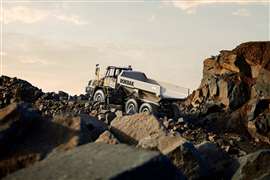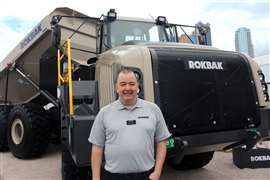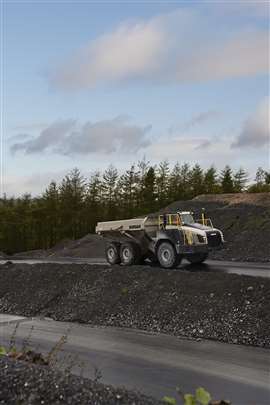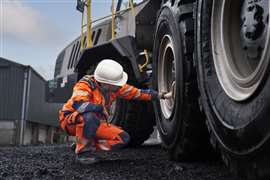Uptime, technology and other secrets to maximising earthmoving efficiency
Partner Content produced by KHL Content Studio
25 June 2025
An engineer might define efficiency as the ratio of work carried out by a machine to the total energy expended. A businessman might simply say ‘getting bang for your buck’.
 A modern hauler has high-quality engineering and cutting-edge technology built in
A modern hauler has high-quality engineering and cutting-edge technology built in
When it comes to the manufacture of heavy equipment, the definition calls to mind a more complex range of disciplines – from R&D to business development, from engineering to software development – perhaps even chemical analysis.
Each of these disciplines is utilised to, among other things, maximise uptime, reduce fuel usage, extend service intervals, and minimise the required operator input.
In other words, to optimise machine efficiency – and the heavier the machine and the longer its working life, the greater the potential for efficiency benefits… or deficiencies.
Unquestionably, haulers fall into this category.
 Rokbak’s senior product manager, Scott Pollock
Rokbak’s senior product manager, Scott Pollock
Scott Pollock, a product specialist with 37 years’ experience in the manufacture of articulated haulers, has seen his share of machine development, as well as the development of manufacturing disciplines.
The changing face of hauling
A one-company man, Pollock has been predominantly based at Rokbak’s manufacturing facility in Motherwell, Scotland, since beginning his career as a technical apprentice there in 1987.
At that time, both rigid and articulated dump trucks (ADTs) were produced at the facility. But following the company’s acquisition by Volvo Construction Equipment in 2014, Rokbak was established in 2021 – a business designed to specialise in the manufacture of the RA30 and RA40 ADTs.
With experience ranging from technical apprentice, through design and test development engineering and customer support, to roles in aftersales and service training, Pollock – now a senior product manager – is well placed to discuss his company’s efforts to advance hauler efficiency.
“The buying culture for haulers has changed dramatically in my time,” he says. “Whereas it used to be a machine that was used and abused, then maybe traded in, it’s now rightly seen as a significant asset for most companies.
“It’s hard to imagine, but 20 or 30 years ago, haulers were seen as little more than mechanical wheelbarrows. Now they’re precision-engineered machines, full of technology; a serious long-term investment for an organisation.
 An ADT operator has no trouble precisely navigating a narrow haul road
An ADT operator has no trouble precisely navigating a narrow haul road
“Whether a business is operating in construction, mining, quarrying, forestry, or the like, there’s a much greater focus on ownership costs, fuel consumption and services provided. It’s no longer just about the metal; it’s about the efficient use of an asset over its lifetime.
“That’s why having a clear relationship with business owners is so important; they need to trust us and trust the messages we give them about protecting and getting the most out of that asset.”
Ever-ready machines
The word that keeps coming up in conversation with Pollock is uptime – a key factor in ensuring optimum efficiency in a machine.
He says, “If a truck is operating in a mine or quarry, it can be set up specifically for those operations. But in the rental market, a truck can be working in different applications from week to week.
“We have to be laser-focused on this – on making sure that any adaptation we make to the trucks is going to have a positive effect on cost of operation, fuel consumption, reliability, and uptime across any given application.
“Customers want trucks to be tolerant to any situation and any operating competence. That’s what we need to be conscious of when we are adapting or updating our products.”
This attention to detail becomes even more crucial when developing a new product – potentially designing it from the wheels up.
In that scenario, says Pollock, teams must take a long look at aspects of use such as ease of operation, operator comfort and, crucially, the cost of operating a machine, including maintenance, fuel consumption, and more.
“Unlike in the past,” he says, “today’s customer wants to know how much it’s going to cost per hour to operate the machine – and we need to have done the maths.”
A design for long life
 Simple maintenance and extended service intervals are key considerations for hauler purchasers
Simple maintenance and extended service intervals are key considerations for hauler purchasers
Very little in the world of heavy industry is an exact science, but precision engineering combined with the latest digital tools is allowing manufacturers to give customers a more accurate picture of what to expect from equipment in terms of uptime and efficiency.
Pollock says, “Reliability is certainly key to maximising efficiency. But big machines like ours take a lot of abuse, and there will be times when – no matter how much tolerance you build into them – something will need to be repaired or replaced.
“This has been another area of focus for us; ensuring that the machines are as straightforward as possible, so any repairs can be carried out quickly and the machine can get back to work.
“The same goes for maintenance – we’re looking at alternative fluids and filtration systems to help us keep trucks running, with longer intervals between maintenance needs.”
When maintenance is required, designing for easy access points is key. Pollock says his team’s design goal is now to limit this essential work as much as possible. As he says, “Minimal downtime, then back to work.”
Unfortunately, where heavy mobile equipment is in constant use, damage is likely to occur and parts will need replacing.
 The articulated hauler is in its element on challenging terrain
The articulated hauler is in its element on challenging terrain
“This is one of the three Ps,” Pollock says, “Product, People and Parts. You have to make sure we’ve got the parts readily available in a location that’s easy to access.
“That means fast-moving parts for planned maintenance – such as filters and fluids – but also major components that may fail. You also want them centrally located to reduce shipment time.
“At the same time, there’s no point having a fully trained technician with all the tools when he’s 400 miles away from the downed machine. The right people have to be in the right place as well.”
Tech and training
In most industries, technology is now seen as a key efficiency driver, and construction, mining and quarrying are no exception.
Making trucks easier and more intuitive for operators is a focus for most design teams. Pollock describes ADT features such as downhill speed control, automatic retarders, traction control, and the soon-to-be-deployed cruise control – among other technologies – that take the strain off the operator and the components, thereby extending their working life.
On-board computers, he says, are constantly reading parameters from the engine, the transmission and the operator input. The truck’s adaptive shifting feature, for example, ensures performance is fine-tuned for optimal fuel efficiency depending on ground conditions, current payload, etc.
While few doubt the potential of technology to make heavy mobile machines more efficient, some do question whether this on-board tech is being used effectively.
Pollock agrees that understanding the tools at your disposal on modern machines is key to maximising efficiency.
He says, “I think the operator’s engagement with the truck is important. We offer instruction so operators understand how to make best use of the trucks – including pre-startup checks, the maintenance checks – basically, looking after the machine.
“For a machine to be used efficiently, it’s important that the operator can access all the available tools – whether that’s software or essential hardware.
“This is the sort of training we offer, either at Motherwell or potentially as part of the machine handover at the customer’s site.”
--------
This article was produced by KHL Content Studio, in collaboration with experts from Rokbak
--------
All images courtesy of Rokbak
--------




